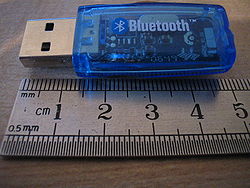Bluetooth is a proprietary open wireless technology standard for exchanging data over short distances (using short-wavelength radio transmissions in the ISM band from 2400–2480 MHz) from fixed and mobile devices, creating personal area networks (PANs) with high levels of security. Created by telecoms vendor Ericsson in 1994, it was originally conceived as a wireless alternative to RS-232 data cables. It can connect several devices, overcoming problems of synchronization.
Bluetooth vs. Wi-Fi (IEEE 802.11)
Bluetooth and Wi-Fi (the brand name for products using IEEE 802.11 standards) have some similar applications: setting up networks, printing, or transferring files. Wi-Fi is intended as a replacement for cabling for general local area network access in work areas. This category of applications is sometimes called wireless local area networks (WLAN). Bluetooth was intended for portable equipment and its applications. The category of applications is outlined as the wireless personal area network (WPAN). Bluetooth is a replacement for cabling in a variety of personally carried applications in any setting and also works for fixed location applications such as smart energy functionality in the home (thermostats, etc.).
Wi-Fi is a wireless version of a common wired Ethernet network, and requires configuration to set up shared resources, transmit files, and to set up audio links (for example, headsets and hands-free devices). Wi-Fi uses the same radio frequencies as Bluetooth, but with higher power, resulting in higher bit rates and better range from the base station. The nearest equivalents in Bluetooth are the DUNprofile, which allows devices to act as modem interfaces, and the PAN profile, which allows for ad-hoc networking.
Near field communication (NFC) is a set of standards for smartphones and similar devices to establish radio communication with each other by touching them together or bringing them into close proximity, usually no more than a few centimetres. Present and anticipated applications include contactless transactions, data exchange, and simplified setup of more complex communications such as Wi-Fi. Communication is also possible between an NFC device and an unpowered NFC chip, called a "tag".
NFC standards cover communications protocols and data exchange formats, and are based on existing radio-frequency identification (RFID) standards includingISO/IEC 14443 and FeliCa.The standards include ISO/IEC 18092 and those defined by the NFC Forum, which was founded in 2004 by Nokia, Philips and Sony, and now has more than 160 members. The Forum also promotes NFC and certifies device compliance.
by Saroj kr ray....


No comments:
Post a Comment